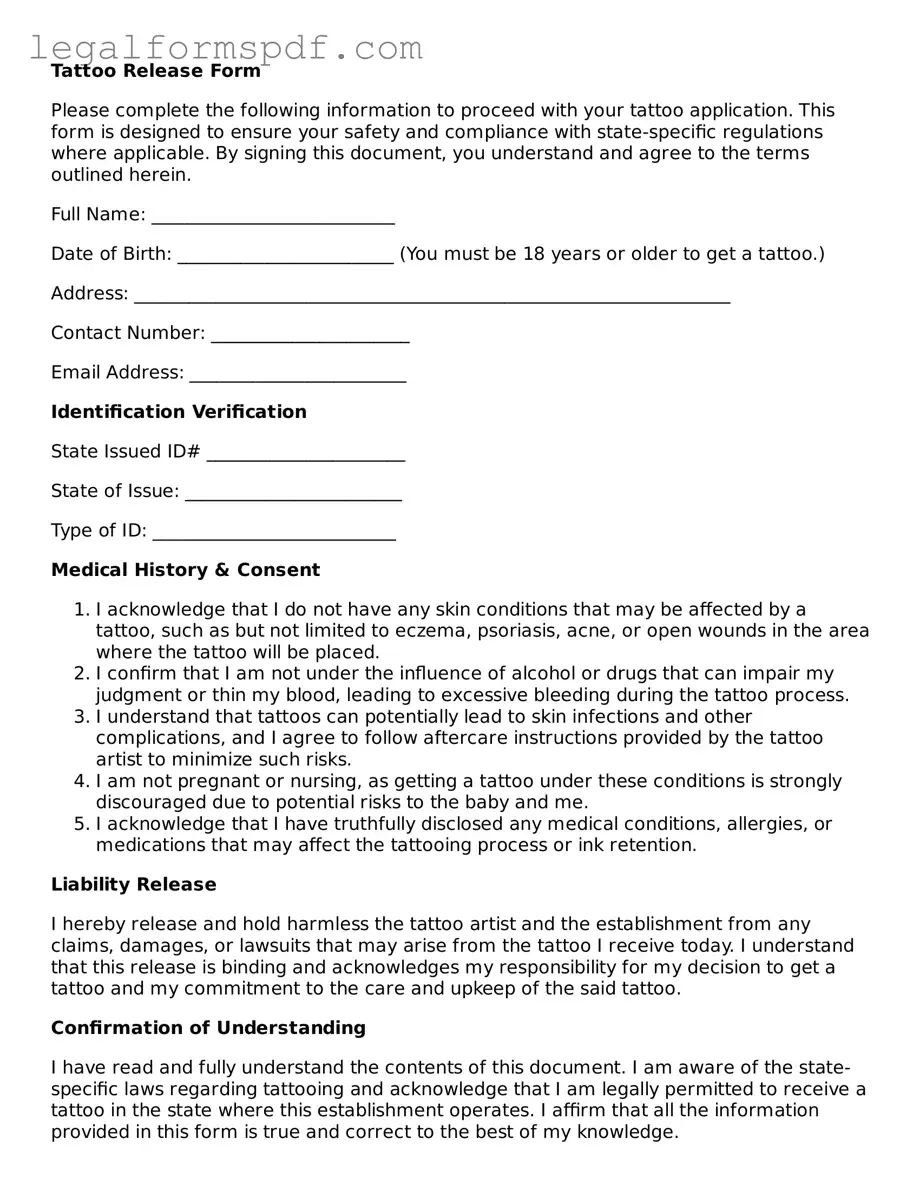What is a Tattoo Release Form?
A Tattoo Release Form is a document both a client and the tattoo artist sign before starting a tattoo session. This form typically covers consent from the client to receive the tattoo, acknowledgement of risks involved, confirmation that the client is of legal age for getting tattooed, and any health considerations that might affect the tattooing process. It's a crucial step to ensure both parties understand the terms and conditions of the tattooing service.
Why do I need to sign a Tattoo Release Form?
Signing a Tattoo Release Form is important for several reasons. It protects you by confirming that you have been informed about and understand the risks associated with getting a tattoo, such as infections or allergic reactions. It also protects the tattoo artist and the shop from potential legal issues that could arise if something goes wrong. Essentially, it's a way to make sure everyone is clear about the procedure and any potential risks, making the tattoo process safer for everyone involved.
What information do I need to provide on a Tattoo Release Form?
You'll be asked to provide some basic personal information such as your name, address, and date of birth to confirm you're of legal age. You'll also need to disclose any medical conditions or allergies that could affect your tattoo experience, such as skin conditions, allergies to ink, or medications that thin your blood. This information helps the tattoo artist ensure your safety during the tattooing process.
Can I get a tattoo without signing a Release Form?
Most reputable tattoo shops will require you to sign a Tattoo Release Form before getting a tattoo. This is a standard practice in the industry to ensure safety and legal compliance. It's unlikely that a professional tattoo artist would agree to perform a tattoo without this form being signed, as it's a crucial part of their operating procedures and legal protection.
Is the information I provide on the Release Form kept confidential?
Yes, the information you provide on a Tattoo Release Form is kept confidential. Tattoo studios understand the importance of privacy and handle personal and medical information with a high level of discretion. The information is used solely for the purpose of the tattoo process and to ensure your safety and well-being.
What happens if I have a medical condition? Can I still get a tattoo?
If you have a medical condition, it's essential to disclose this on your Tattoo Release Form. Depending on the condition, you may still be able to get a tattoo, but extra precautions may be needed. For instance, if you're prone to excessive bleeding, the artist might need to take specific steps to manage this. It's always best to discuss any medical concerns with your tattoo artist before your appointment so they can provide the best advice and adjustments.
Can minors sign a Tattoo Release Form?
In most places, minors (individuals under the age of 18) are not legally allowed to get tattoos, even with parental consent. Therefore, minors typically cannot sign a Tattoo Release Form in a legally binding way. The age requirements can vary by location, so it's important to check the laws in your area. Always ensure you meet the age criteria before planning to get a tattoo.
What should I do if I'm not comfortable with the content of the Tattoo Release Form?
If you're uncomfortable with any parts of the Tattoo Release Form or if anything is unclear, it's important to discuss your concerns with the tattoo artist before signing. A reputable tattoo artist will be willing to explain any part of the form and address your concerns. Remember, getting a tattoo is a significant decision, and you should feel completely comfortable and informed throughout the process.
Where can I find a copy of the Tattoo Release Form?
Tattoo Release Forms are usually provided by the tattoo studio where you plan to get your tattoo. Each studio might have its own version of the form, tailored to its policies and the legal requirements of the area. You can typically request a copy of the form in advance to review it. Some studios might also offer digital versions on their websites for you to look at before your appointment.
